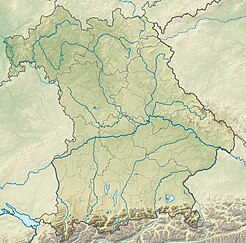RIAS transmitter yard
|
RIAS transmitter yard
|
||
|---|---|---|
| Basic data | ||
| Place: | Hof (Saale) | |
| Country: | Bavaria | |
| Country: | Germany | |
| Altitude : | 532 m above sea level NHN | |
| Coordinates: 50 ° 19 ′ 9.3 ″ N , 11 ° 53 ′ 50.5 ″ E | ||
| Use: | Telecommunication system , radio transmitter | |
| Demolition : | October 19, 1994 | |
| Data on the transmission system | ||
| Number of towers / masts: | 2 | |
| Height of the towers / masts : | 100 m | |
| Construction time: | 1948 | |
| Operating time: | 1948-1993 | |
| Last modification (antenna) : | 1952 | |
| Last modification (transmitter) : | 1989 | |
| Waveband : | AM station | |
| Radio : | MW broadcasting | |
| Send type: | Directional radio | |
| Shutdown : | December 31, 1993 | |
| Position map | ||
|
|
||
The RIAS station Hof was next to the station Britz the second most important station of the former Berlin radio station RIAS 1 .
The RIAS transmitter Hof was located on the area of a barracks on the western outskirts of Hof , in the Bavarian Upper Franconia . Was the legal basis for its operation, such as the VoA - / RFE - Sender Ismaning , the agreement between the Federal Republic of Germany and the United States on the operation of certain radio systems within the Federal Republic of June 11, 1952. Its location was only about six kilometers from the border with GDR removed. It was put into operation in 1948 to supply the south of the GDR and originally used two self-radiating masts, each 50 meters high, isolated from the ground as a transmitting antenna. In 1952 these were replaced by two masts, each 100 meters high, which had stood in Berlin-Britz until 1949. The former mobile soldier's transmitter "Gustav" was initially used as the transmitter, the HF output power of which was increased to 40 kW. It was replaced in 1950 by a stationary 40 kW Telefunken transmitter. In September 1989 a fully transistorized 50 kW transmitter from Nautel was installed in Hof.
The program was played from Berlin via a so-called booty cable through the GDR. This resulted in an embarrassing breakdown in the late autumn of 1978 when the RIAS program was accidentally put on radio stations in the GDR and broadcast on them. The RIAS medium wave transmitter Hof was only allowed to broadcast during the day due to the requirements of the Geneva wave plan . The transmission frequency used was initially 629 kHz, from March 1950 then 719 kHz and from April 1950 finally 683 kHz. From the 1970s onwards, Hof broadcasted on 854 kHz during the day and on 683 kHz at night, while RIAS-2 was broadcast in Berlin-Britz on 683 kHz during the day and on 854 kHz at night. With the entry into force of the 2nd Geneva Wave Plan on November 23, 1978, transmission was over 684 kHz. From that day on, the GDR jammers were switched off against the RIAS frequency.
In contrast to Berlin-Britz, there was no FM transmitter in Hof . However, since 1964 there had been a VHF broadcasting station for the distribution of the RIAS program on the Großer Waldstein , 25 km south , to which the RIAS program was transmitted via a 60-meter mast via directional radio. The program RIAS 2 was transmitted on 91.2 MHz with a transmission power of 20 kW.
After German reunification, the RIAS was dissolved in 1993. The RIAS transmitter in Hof was shut down on December 31, 1993. The two transmitter masts were blown up simultaneously on October 19, 1994 at 2 p.m. The transmitter was transported to Mühlacker ( transmitter Mühlacker ) and rebuilt there. It should serve to broadcast the Deutschlandradio program on 684 kHz in daytime operation. However, this could not be implemented for reasons of electromagnetic environmental compatibility .
literature
- Gerd Klawitter: 100 years of radio technology in Germany. Volume 2 radio stations and measuring stations around Berlin. Funk Verlag Bernhard Hein, Dessau 2002, ISBN 3-89685-511-5 .
See also
Web links
- Information on the former RIAS station Hof 684 kHz ( Memento from June 10, 2008 in the Internet Archive )
- RIAS transmitter yard. In: Structurae
- Video of the demolition

